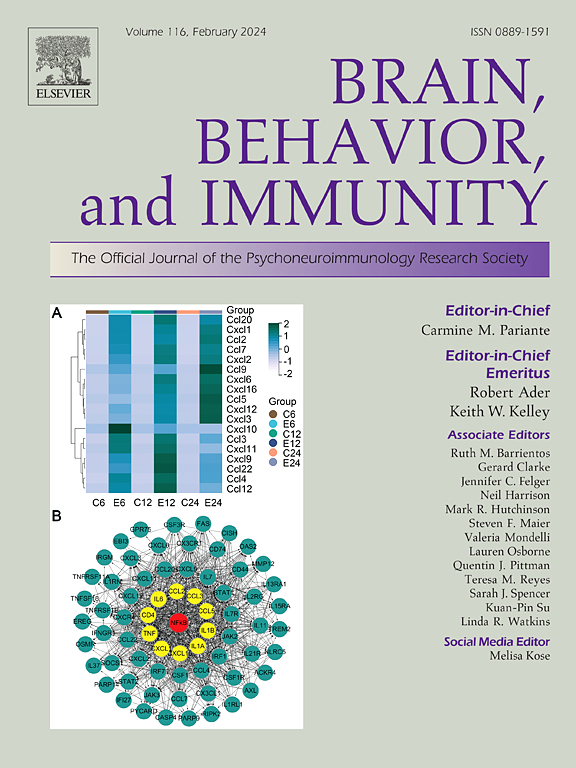研究生命早期免疫挑战的含小胶质细胞的类脑模型
IF 8.8
2区 医学
Q1 IMMUNOLOGY
引用次数: 0
摘要
产前感染和母体免疫系统的激活被认为是导致神经发育障碍(NDDs)的原因之一,这种慢性疾病通常与大脑异常有关。小胶质细胞是大脑的常驻免疫细胞,在神经发育过程中发挥着关键作用。小胶质细胞功能紊乱会导致大脑异常,增加患 NDDs 的风险。母体和胎儿的免疫系统如何影响人类的神经发育并导致 NDDs 目前仍不清楚。造成这一知识空白的一个重要原因是,在人类环境中研究暴露于产前风险因素的影响具有挑战性。在这里,我们描述了一种具有整合小胶质细胞(COiMg)的脑器质(CO)模型。这些有机体表达典型的小胶质细胞标记并对炎症刺激做出反应。小胶质细胞的存在会影响脑器质体的发育,包括细胞密度和神经分化,并调节几种纤毛细胞和间充质细胞标志物的表达。此外,COiMg和不含小胶质细胞的类器官对炎症刺激表现出相似但不同的反应。此外,IFN-γ诱导脑有机体发生显著的转录和结构变化,这些变化似乎受小胶质细胞存在的调节。特别是,研究发现干扰素-γ(IFN-γ)改变了与自闭症有关的基因的表达。该模型为研究炎症扰动和小胶质细胞的存在如何影响神经发育过程提供了一种宝贵的工具。本文章由计算机程序翻译,如有差异,请以英文原文为准。
A microglia-containing cerebral organoid model to study early life immune challenges
Prenatal infections and activation of the maternal immune system have been proposed to contribute to causing neurodevelopmental disorders (NDDs), chronic conditions often linked to brain abnormalities. Microglia are the resident immune cells of the brain and play a key role in neurodevelopment. Disruption of microglial functions can lead to brain abnormalities and increase the risk of developing NDDs. How the maternal as well as the fetal immune system affect human neurodevelopment and contribute to NDDs remains unclear. An important reason for this knowledge gap is the fact that the impact of exposure to prenatal risk factors has been challenging to study in the human context. Here, we characterized a model of cerebral organoids (CO) with integrated microglia (COiMg). These organoids express typical microglial markers and respond to inflammatory stimuli. The presence of microglia influences cerebral organoid development, including cell density and neural differentiation, and regulates the expression of several ciliated and mesenchymal cell markers. Moreover, COiMg and organoids without microglia show similar but also distinct responses to inflammatory stimuli. Additionally, IFN-γ induced significant transcriptional and structural changes in the cerebral organoids, that appear to be regulated by the presence of microglia. Specifically, interferon-gamma (IFN-γ) was found to alter the expression of genes linked to autism. This model provides a valuable tool to study how inflammatory perturbations and microglial presence affect neurodevelopmental processes.
求助全文
通过发布文献求助,成功后即可免费获取论文全文。
去求助
来源期刊
CiteScore
29.60
自引率
2.00%
发文量
290
审稿时长
28 days
期刊介绍:
Established in 1987, Brain, Behavior, and Immunity proudly serves as the official journal of the Psychoneuroimmunology Research Society (PNIRS). This pioneering journal is dedicated to publishing peer-reviewed basic, experimental, and clinical studies that explore the intricate interactions among behavioral, neural, endocrine, and immune systems in both humans and animals.
As an international and interdisciplinary platform, Brain, Behavior, and Immunity focuses on original research spanning neuroscience, immunology, integrative physiology, behavioral biology, psychiatry, psychology, and clinical medicine. The journal is inclusive of research conducted at various levels, including molecular, cellular, social, and whole organism perspectives. With a commitment to efficiency, the journal facilitates online submission and review, ensuring timely publication of experimental results. Manuscripts typically undergo peer review and are returned to authors within 30 days of submission. It's worth noting that Brain, Behavior, and Immunity, published eight times a year, does not impose submission fees or page charges, fostering an open and accessible platform for scientific discourse.

 求助内容:
求助内容: 应助结果提醒方式:
应助结果提醒方式:


